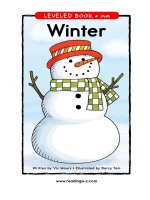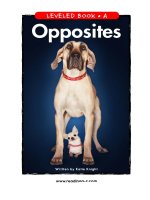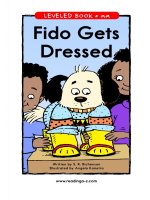raz ll12 flyingmachine
Bạn đang xem bản rút gọn của tài liệu. Xem và tải ngay bản đầy đủ của tài liệu tại đây (1.61 MB, 22 trang )
LEVELED BOOK • L
Fantastic Flying Machines
Written by John Meyer and Elizabeth Austin
www.readinga-z.com
Fantastic Flying Machines
A Reading A–Z Level L Leveled Book • Word Count: 457
Visit
www.readinga-z.com for thousands of books and materials.
I•L•P
Photo Credits:
Front cover: Courtesy of Tom Tschida/Dryden Flight Research Center/NASA; back cover, 13 (right), 15 (right), 19: © ArtToday; title page: ©
Learning A-Z, Inc.; pages 4, 5 (left), 15 (left): © Jupiterimages Corporation; pages 5 (right), 6 (left): © The Granger Collection, NYC; page 6
(right): ©Science Museum/SSPL /The Image Works; page 7: courtesy of Library of Congress, Prints & Photographs Div [LC-W861-35]; page 8:
© PhotoStock-Israel/Alamy; page 9 (left): courtesy of Photographer’s Mate 3rd Class Todd Frantom/U.S. Navy; page 9 (right): © Ismaeljorda/
Dreamstime.com; page 10: courtesy of Paul Farley/U.S. Navy; page 11: courtesy of U.S. Air Force photo by Staff Sgt. James Wilkinson; page 12:
© ZUMA Press, Inc./Alamy; page 13 (left): courtesy of Airman Kyle T. Voigt/ U.S. Navy; page 14: © iStockphoto.com/VMJones; page 16 (left): ©
iStockphoto.com/Charles Shapiro; page 16 (right): © Louie Psihoyos/Corbis; page 17: courtesy of NASA/JSC; page 18 (all): courtesy of NASA
Front cover: The Proteus, a very high-flying observation airplane
Back cover: A military helicopter
Title page: The Lockheed Constellation, used to carry the U.S. president in the 1950s
Fantastic Flying Machines
Level L Leveled Book
© Learning A–Z
Written by John Meyer and Elizabeth Austin
All rights reserved.
www.readinga-z.com
Correlation
LEVEL L
Fountas & Pinnell
Reading Recovery
DRA
K
18
20
www.readinga-z.com
Written by John Meyer and Elizabeth Austin
Fantastic Flying Machines
Table of Contents
Introduction..................................................................................4
History of Flight...........................................................................6
Airplanes.......................................................................................8
Helicopters.................................................................................... 12
Blimps and Balloons.................................................................... 15
Rockets and Spaceships.............................................................. 17
Other Ways to Fly......................................................................... 19
Index.............................................................................................. 20
3
Fantastic Flying Machines • Level L
4
Imagine if you could fly like a bird. Where would you go?
What would you see? Today, many people can fly thanks
to fantastic flying machines.
Introduction
Table of Contents
Introduction..................................................................................4
History of Flight...........................................................................6
Airplanes.......................................................................................8
Helicopters.................................................................................... 12
Blimps and Balloons.................................................................... 15
Rockets and Spaceships.............................................................. 17
Other Ways to Fly......................................................................... 19
Index.............................................................................................. 20
3
Fantastic Flying Machines • Level L
4
Imagine if you could fly like a bird. Where would you go?
What would you see? Today, many people can fly thanks
to fantastic flying machines.
Introduction
These wings flapped when the person
moved his arms and legs.
Leonardo da Vinci’s helicopter drawing
People have always wanted to fly. They watched birds
fly, and some tried tying wings to their arms. Long ago, an
artist even drew plans to make a helicopter. He drew his
idea, but he didn’t build it.
5
Fantastic Flying Machines • Level L
6
People kept trying to fly. Two French brothers made the
first hot-air balloon. Another man made the first glider
that worked. Later, someone made a better glider that
could sail in the air for a long time.
George Cayley built the first glider
that carried a person.
History of Flight
A sketch of one of Cayley’s first
gliders
These wings flapped when the person
moved his arms and legs.
Leonardo da Vinci’s helicopter drawing
People have always wanted to fly. They watched birds
fly, and some tried tying wings to their arms. Long ago, an
artist even drew plans to make a helicopter. He drew his
idea, but he didn’t build it.
5
Fantastic Flying Machines • Level L
6
People kept trying to fly. Two French brothers made the
first hot-air balloon. Another man made the first glider
that worked. Later, someone made a better glider that
could sail in the air for a long time.
George Cayley built the first glider
that carried a person.
History of Flight
A sketch of one of Cayley’s first
gliders
Wilbur Wright watches his brother Orville make his famous flight.
Brothers named Orville and Wilbur Wright studied all of
these ideas. They thought about how some ideas worked
and why some didn’t work. They tested their own ideas.
Finally, they designed an airplane that worked. One day,
Orville flew the plane for one full minute. It flew for
260 meters (850 ft). People could fly!
7
Fantastic Flying Machines • Level L
8
Airplanes have changed a lot since the early days of flight.
Today’s large airplanes carry about 450 people on trips.
They also carry people’s bags and cargo. Has your family
flown on one?
Airplanes
This commercial airplane carries hundreds of passengers around the world every day.
Wilbur Wright watches his brother Orville make his famous flight.
Brothers named Orville and Wilbur Wright studied all of
these ideas. They thought about how some ideas worked
and why some didn’t work. They tested their own ideas.
Finally, they designed an airplane that worked. One day,
Orville flew the plane for one full minute. It flew for
260 meters (850 ft). People could fly!
Fantastic Flying Machines • Level L
7
8
Airplanes have changed a lot since the early days of flight.
Today’s large airplanes carry about 450 people on trips.
They also carry people’s bags and cargo. Has your family
flown on one?
Airplanes
This commercial airplane carries hundreds of passengers around the world every day.
A Navy jet fighter takes off from an aircraft carrier.
Jet gases form streaks of cloud in the sky.
Many modern planes that are built to fly high or fast use jet
engines. A jet engine forces hot gases in a stream behind it.
That force pushes a plane forward.
9
Fantastic Flying Machines • Level L
10
Many planes have propeller engines. Propeller blades spin
like a fan’s blades.
A Navy plane with four propeller engines
A Navy jet fighter takes off from an aircraft carrier.
Jet gases form streaks of cloud in the sky.
Many modern planes that are built to fly high or fast use jet
engines. A jet engine forces hot gases in a stream behind it.
That force pushes a plane forward.
9
Fantastic Flying Machines • Level L
10
Many planes have propeller engines. Propeller blades spin
like a fan’s blades.
A Navy plane with four propeller engines
Planes carry things
quickly over long
distances. Cargo planes
and mail planes fly
around the world. Big
military planes carry
trucks, food, and troops.
This plane can hold 132,000 kilograms (291,000 lbs)
of cargo.
11
Fantastic Flying Machines • Level L
12
A helicopter lands on top of a building.
Helicopters can land
almost anywhere.
They can also fly
backward and
sideways. They can
even stop in midair!
Helicopters
Planes carry things
quickly over long
distances. Cargo planes
and mail planes fly
around the world. Big
military planes carry
trucks, food, and troops.
This plane can hold 132,000 kilograms (291,000 lbs)
of cargo.
11
Fantastic Flying Machines • Level L
12
A helicopter lands on top of a building.
Helicopters can land
almost anywhere.
They can also fly
backward and
sideways. They can
even stop in midair!
Helicopters
Troops board a military helicopter.
A large helicopter carries a big bucket
of water over a wildfire.
Some helicopters are designed to lift heavy loads.
These helicopters need two rotors on top. Firefighters
sometimes use these types of helicopters to fight forest fires.
13
Fantastic Flying Machines • Level L
14
Helicopters are much faster than cars. They can be used as
ambulances. Police use them to chase criminals. Helicopters
help rescue people who are lost, too.
A helicopter ambulance transports sick and injured people.
Troops board a military helicopter.
A large helicopter carries a big bucket
of water over a wildfire.
Some helicopters are designed to lift heavy loads.
These helicopters need two rotors on top. Firefighters
sometimes use these types of helicopters to fight forest fires.
13
Fantastic Flying Machines • Level L
14
Helicopters are much faster than cars. They can be used as
ambulances. Police use them to chase criminals. Helicopters
help rescue people who are lost, too.
A helicopter ambulance transports sick and injured people.
Beautiful balloons dot the sky.
Hot-air balloon passengers ride in a basket.
Blimps and Balloons
Hot-air balloons are pushed by the wind. They fly
slowly and are very quiet. Many balloons have fun
and colorful designs.
15
Fantastic Flying Machines • Level L
16
Most blimps have two small propeller engines.
Pilots steer them where they want to go.
Some blimps are used to take photos of sporting events.
Blimps are often used to film sporting events.
Riding in a blimp gives an amazing view.
Beautiful balloons dot the sky.
Hot-air balloon passengers ride in a basket.
Blimps and Balloons
Hot-air balloons are pushed by the wind. They fly
slowly and are very quiet. Many balloons have fun
and colorful designs.
15
Fantastic Flying Machines • Level L
16
Most blimps have two small propeller engines.
Pilots steer them where they want to go.
Some blimps are used to take photos of sporting events.
Blimps are often used to film sporting events.
Riding in a blimp gives an amazing view.
Rockets and
Spaceships
Powerful rockets work
like big engines. Rocket
engines force hot air and
gas out the back to create
thrust. Rockets helped
people fly to the Moon
and back.
The Saturn V rocket carried astronauts to the Moon.
17
Fantastic Flying Machines • Level L
18
A space shuttle rides a rocket into space. When it comes
back to Earth, its wings let it land like an airplane.
A space shuttle uses rockets to lift off.
A space shuttle in orbit
Rockets and
Spaceships
Powerful rockets work
like big engines. Rocket
engines force hot air and
gas out the back to create
thrust. Rockets helped
people fly to the Moon
and back.
The Saturn V rocket carried astronauts to the Moon.
17
Fantastic Flying Machines • Level L
18
A space shuttle rides a rocket into space. When it comes
back to Earth, its wings let it land like an airplane.
A space shuttle uses rockets to lift off.
A space shuttle in orbit
Other Ways to Fly
Once, people only dreamed
of flying like birds. Now,
hang gliders drift on air.
You can ride in a hot-air
balloon. Airplanes fly
everywhere. Where
would you like to fly?
A hang glider soars over a beach.
19
Fantastic Flying Machines • Level L
20
Wright, Orville and Wilbur, 7
space shuttle, 18
rotor, 13
propeller, 10, 16
jet engines, 9
Index
Other Ways to Fly
Once, people only dreamed
of flying like birds. Now,
hang gliders drift on air.
You can ride in a hot-air
balloon. Airplanes fly
everywhere. Where
would you like to fly?
A hang glider soars over a beach.
19
Fantastic Flying Machines • Level L
20
Wright, Orville and Wilbur, 7
space shuttle, 18
rotor, 13
propeller, 10, 16
jet engines, 9
Index
LEVELED BOOK • L
Fantastic Flying Machines
Written by John Meyer and Elizabeth Austin
www.readinga-z.com
Fantastic Flying Machines
A Reading A–Z Level L Leveled Book • Word Count: 457
Visit
www.readinga-z.com for thousands of books and materials.
I•L•P
Photo Credits:
Front cover: Courtesy of Tom Tschida/Dryden Flight Research Center/NASA; back cover, 13 (right), 15 (right), 19: © ArtToday; title page: ©
Learning A-Z, Inc.; pages 4, 5 (left), 15 (left): © Jupiterimages Corporation; pages 5 (right), 6 (left): © The Granger Collection, NYC; page 6
(right): ©Science Museum/SSPL /The Image Works; page 7: courtesy of Library of Congress, Prints & Photographs Div [LC-W861-35]; page 8:
© PhotoStock-Israel/Alamy; page 9 (left): courtesy of Photographer’s Mate 3rd Class Todd Frantom/U.S. Navy; page 9 (right): © Ismaeljorda/
Dreamstime.com; page 10: courtesy of Paul Farley/U.S. Navy; page 11: courtesy of U.S. Air Force photo by Staff Sgt. James Wilkinson; page 12:
© ZUMA Press, Inc./Alamy; page 13 (left): courtesy of Airman Kyle T. Voigt/ U.S. Navy; page 14: © iStockphoto.com/VMJones; page 16 (left): ©
iStockphoto.com/Charles Shapiro; page 16 (right): © Louie Psihoyos/Corbis; page 17: courtesy of NASA/JSC; page 18 (all): courtesy of NASA
Front cover: The Proteus, a very high-flying observation airplane
Back cover: A military helicopter
Title page: The Lockheed Constellation, used to carry the U.S. president in the 1950s
Fantastic Flying Machines
Level L Leveled Book
© Learning A–Z
Written by John Meyer and Elizabeth Austin
All rights reserved.
www.readinga-z.com
Correlation
LEVEL L
Fountas & Pinnell
Reading Recovery
DRA
K
18
20
www.readinga-z.com
Written by John Meyer and Elizabeth Austin
Fantastic Flying Machines









